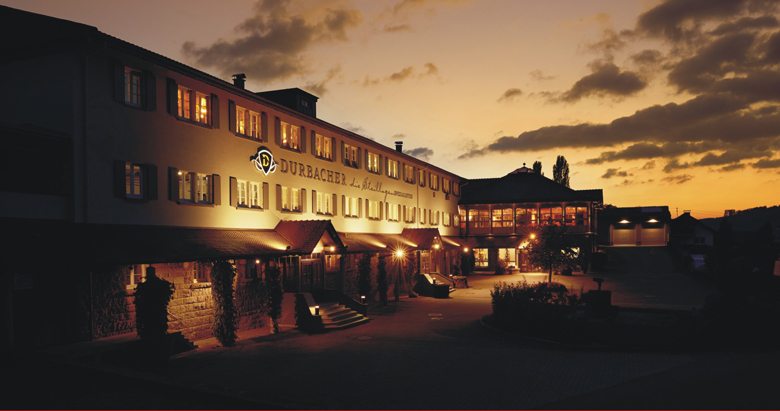The Durbach winegrowers – the steep slopes specialists
that make the individuality of each grape variety tasteable
https://www.bonvinitas.com/media/reviews/photos/thumbnail/780x480c/e2/70/a5/durbacher-winzergenossenschaft-durbach-88-1754735482.jpg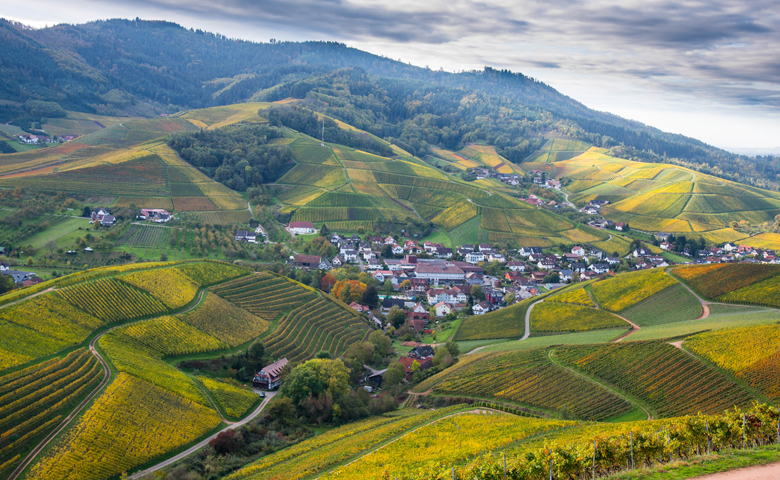 The approximately 250 winegrowing families of the Durbacher Winzer Cooperative are closely connected to their vines and nature. A certain pride in the vineyards and the wine is undeniable. The proportion of full-time winegrowers is above average. The cooperative has been existing since 1928, and its members own extensive property on Durbach's best steep slopes. Regular, prestigious awards at both national and international levels testify to the high quality standards of Durbach's winegrowers. Behind every fine wine lies the work, diligence, and experience of the steep-slope specialists. Each vine is painstakingly tended by hand. This requires a great deal of idealism and passion. A quote from one of the winegrowers, "The feeling of not only producing outstanding wines, but also preserving a piece of cultural landscape fills us with great joy." In Durbach, winemaking is lived and loved – and you can taste it. The know-how from the vineyard to the cellar can be tasted in every glass of Durbach wine. Through traditional yet progressive cellar management, each wine becomes an individual.
The approximately 250 winegrowing families of the Durbacher Winzer Cooperative are closely connected to their vines and nature. A certain pride in the vineyards and the wine is undeniable. The proportion of full-time winegrowers is above average. The cooperative has been existing since 1928, and its members own extensive property on Durbach's best steep slopes. Regular, prestigious awards at both national and international levels testify to the high quality standards of Durbach's winegrowers. Behind every fine wine lies the work, diligence, and experience of the steep-slope specialists. Each vine is painstakingly tended by hand. This requires a great deal of idealism and passion. A quote from one of the winegrowers, "The feeling of not only producing outstanding wines, but also preserving a piece of cultural landscape fills us with great joy." In Durbach, winemaking is lived and loved – and you can taste it. The know-how from the vineyard to the cellar can be tasted in every glass of Durbach wine. Through traditional yet progressive cellar management, each wine becomes an individual. To whet your appetite:
2023 Durbacher Plauelrain Klingelberger (Riesling) Spätlese dry * * *
 The aroma itself reveals that this isn't a run-of-the-mill wine. A mineral, flint note dominates. The combination of smoky and mineral components, accompanied by earthy, nutty notes, is surprising. Full and expressive, yet still leaves room for subtle nuances of mint and anise. The palate then becomes truly bright. This is where citrus and ginger notes enter. Fresh leaves and white pepper provide freshness and vibrancy. In the background, nuances of curry and lemongrass, as well as banana peel and rosemary, emerge. The well-balanced acidity ensures constant pressure on the palate. Forward we go! No rest. It's tremendous fun to follow this path and taste something new with every sip. Drinking this Riesling means loving life. A high fun factor!
The aroma itself reveals that this isn't a run-of-the-mill wine. A mineral, flint note dominates. The combination of smoky and mineral components, accompanied by earthy, nutty notes, is surprising. Full and expressive, yet still leaves room for subtle nuances of mint and anise. The palate then becomes truly bright. This is where citrus and ginger notes enter. Fresh leaves and white pepper provide freshness and vibrancy. In the background, nuances of curry and lemongrass, as well as banana peel and rosemary, emerge. The well-balanced acidity ensures constant pressure on the palate. Forward we go! No rest. It's tremendous fun to follow this path and taste something new with every sip. Drinking this Riesling means loving life. A high fun factor!
Combining ecology and economy in a meaningful way - making the individual tasteful
One of the most important principles of Durbach's winemakers is to sensibly combine ecology and economy. Nature itself takes on a significant portion of the work in the vineyard, and a healthy environment is the winemakers' best asset. But humans can and must also make their contribution if they want to perfect the work and reap the rewards. For example, hand-picking pays off, because no machine can do that, that very special eye for the essentials!
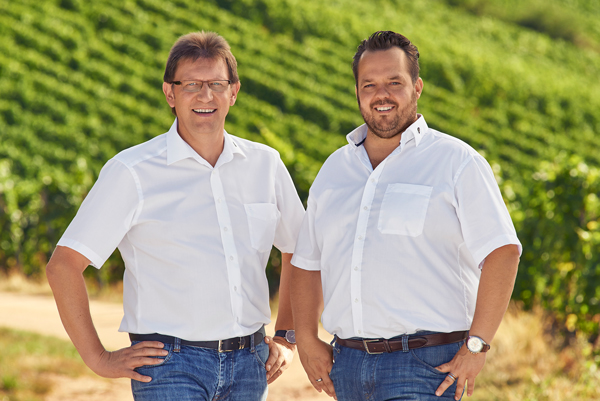 Making the terroir and individual characteristics tasteful is the job of the first cellar master, Rüdiger Nilles. As a "child of the Mosel", he is predestined for this and is extremely familiar with steep slopes and Riesling. He is supported in his diverse tasks by the second cellar master, Alfred Männle, and his dedicated team, who are always at his side. Each grape variety and individual vineyard has its own requirements. This is also the greatest challenge for the cellar team, as they have to accompany each wine through its entire development. A consistent quality philosophy from pruning to bottling, based on very careful working methods, is therefore essential. Another focus is the topic of sustainability. This extends across all areas, from the vineyard to cellar management and sales, right through to social aspects among the employees. The Durbach winegrowers have been recognized as a volunteer-friendly company among others by the state government of Baden-Württemberg.
Making the terroir and individual characteristics tasteful is the job of the first cellar master, Rüdiger Nilles. As a "child of the Mosel", he is predestined for this and is extremely familiar with steep slopes and Riesling. He is supported in his diverse tasks by the second cellar master, Alfred Männle, and his dedicated team, who are always at his side. Each grape variety and individual vineyard has its own requirements. This is also the greatest challenge for the cellar team, as they have to accompany each wine through its entire development. A consistent quality philosophy from pruning to bottling, based on very careful working methods, is therefore essential. Another focus is the topic of sustainability. This extends across all areas, from the vineyard to cellar management and sales, right through to social aspects among the employees. The Durbach winegrowers have been recognized as a volunteer-friendly company among others by the state government of Baden-Württemberg.
The grape varieties
Durbach wines are exceptionally diverse. Different grape varieties and flavors create a broad selection with plenty to discover. Pinot Noir is dominating, accounting for 43.5% of the vineyard area, and Riesling, known locally as Klingelberger, accounts for 28%. This is followed by Müller-Thurgau/Rivaner and Pinot Gris, each accounting for 10%, followed by Clémenceau (Traminer) and Pinot Blanc, as well as Scheurebe, Gewürztraminer, Cabernet Sauvignon, Chardonnay, Sauvignon Blanc, and Muscat.
To illustrate the diversity of the wines, six wines from the four top vineyards were available for tasting.
The Ölberg (Mount of Olives)
with its biblical-sounding name, is a striking vineyard at the entrance to Durbach and, with a gradient of up to 80%, the steepest vineyard. Facing west to south, the vineyard lies at an elevation of 220 to 260 meters above sea level and comprises almost 14 hectares of vineyards on granite-weathered soils. The bouquet varieties Clevner (Traminer), Gewürztraminer, and Scheurebe thrive here.
In addition to its extremely steep incline, the Steinberg (stone mountain)
is also characterized by a climatically favorable south-facing slope. The special soil composition, due to the high levels of sunlight, acts like a tiled stove, gradually transferring the heat to the vines. Also typical of this site is an exceptionally long growing and ripening period, ideal for noble sweet bouquet wines.
The Plauelrain vineyard 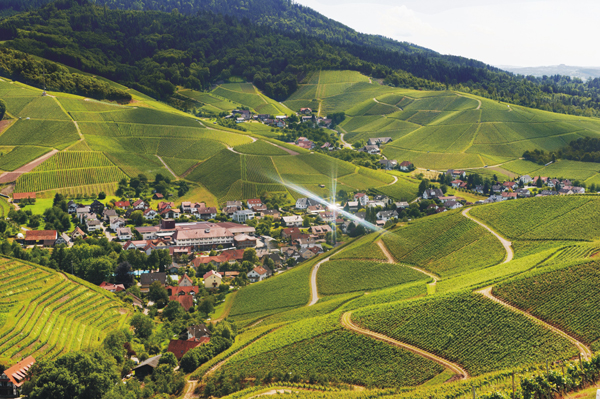 lon the south slopes of the Durbach Valley, is particularly well-suited to demanding grape varieties. A continuous forest border protects the vineyard from cold winds. These natural conditions ensure an excellent microclimate and enable the highest quality wines.
lon the south slopes of the Durbach Valley, is particularly well-suited to demanding grape varieties. A continuous forest border protects the vineyard from cold winds. These natural conditions ensure an excellent microclimate and enable the highest quality wines.
The Kochberg
is a southeast- and southwest-facing site with weathered granite soils combined with sandy loam. The soils are therefore somewhat richer and ideally suited to Burgundy grapes, especially Pinot Noir.
2023 Durbacher Steinberg Sauvignon Blanc dry quality wine
 The fragrance creeps in gently. A mosaic of aromas. Notes of flint, smoke, marzipan, and lychee create a perfect olfactory picture. Amazingly delicate, yet so expressive. Oops, here I come! The taste immediately takes center stage. Pure presence. What a performance! From grapefruit to mirabelle plum, through green leaves and fresh grass to fennel and boxwood. From anise to ginger, green pepper, caraway, and curry. A delicate fruity sweetness provides melting power and fullness. With this abundance of aromas, it's recommended to take a deep breath so the oxygen can release everything this wine has to offer. Power paired with a wonderful lightness. Pure drinking pleasure!
The fragrance creeps in gently. A mosaic of aromas. Notes of flint, smoke, marzipan, and lychee create a perfect olfactory picture. Amazingly delicate, yet so expressive. Oops, here I come! The taste immediately takes center stage. Pure presence. What a performance! From grapefruit to mirabelle plum, through green leaves and fresh grass to fennel and boxwood. From anise to ginger, green pepper, caraway, and curry. A delicate fruity sweetness provides melting power and fullness. With this abundance of aromas, it's recommended to take a deep breath so the oxygen can release everything this wine has to offer. Power paired with a wonderful lightness. Pure drinking pleasure!
2022 Durbacher Kochberg Pinot Noir red wine Spätlese dry * * *
 The masculine character of this Pinot Noir is evident even in the aroma. Compactness and directness are emphasized. Plums, sloe, and dark forest berries dominate the fragrance. Wood smoke and juniper provide minerality and spice. Cloves and cinnamon complete the aromatics, which conclude with a rich note of mocha and tobacco.
The masculine character of this Pinot Noir is evident even in the aroma. Compactness and directness are emphasized. Plums, sloe, and dark forest berries dominate the fragrance. Wood smoke and juniper provide minerality and spice. Cloves and cinnamon complete the aromatics, which conclude with a rich note of mocha and tobacco.
The taste is a balancing act between incipient maturity and youthful insouciance. The path is clear. Great starting conditions and good development potential. The slight spiciness of black pepper opens the scene. A slight provocation. A cherry marinated in brandy falls into a bed of bittersweet chocolate. Sticks of candied ginger and orangeade are served. But that's not all. The finale is exquisite. While the strings have been at work up until now, saxophones and timpani now join in. Cinnamon, juniper, licorice, and a hint of soy sauce bring the necessary spice. And this interplay seems unlikely to end. This wine exudes self-assurance. Everything that the soil, climate, and the work of the winemaker and cellar master have created over the course of a year is captured here. Pure terroir. The finest.
2023 Durbacher Ölberg 1863 Riesling & Gewürztraminer Quality Dry Wine
 The year 1863 saw the birth of the legendary Ölberg wines. At that time, a grand ducal decree ensured that only Durbach citizens had the privilege of cultivating this exposed site. The aroma alone transports one to heavenly realms. Pure exoticism meets clear minerality. Wild roses and flint as the basic elements. Caramel and honey anise and ginger, mango and orange peel in intimate harmony. What's amazing is that this aroma lingers forever and doesn't disappear after a short time like with many other blends. Here, you wish you had more than just a nose. One inevitably wonders: can the taste keep up?
The year 1863 saw the birth of the legendary Ölberg wines. At that time, a grand ducal decree ensured that only Durbach citizens had the privilege of cultivating this exposed site. The aroma alone transports one to heavenly realms. Pure exoticism meets clear minerality. Wild roses and flint as the basic elements. Caramel and honey anise and ginger, mango and orange peel in intimate harmony. What's amazing is that this aroma lingers forever and doesn't disappear after a short time like with many other blends. Here, you wish you had more than just a nose. One inevitably wonders: can the taste keep up?
It can! What abundance, what power. Everything in the right place. "Be embraced, millions, this wine of the whole world," one would like to exclaim, in a slight variation on Schiller's "Ode to Joy." This combination of diverse components, this harmony; all-encompassing. A gustatory ascent to heaven, almost a little otherworldly. Even the first sip is astonishing. It's like reading an exciting book. You can hardly wait to turn the page, or rather, to take the next sip. A bright, sparkling firework display, almost impossible to grasp with the first sip. A wine that is not only absorbed by the nose and mouth, but projects images in the mind. Luminous, cheerful, new beginnings, new paths, and vitality. You almost think you're losing touch with reality. Riesling and Gewürztraminer, sought and found. A fantastic wine, tremendous fun!
2024 Durbacher Plauelrain Chardonnay quality wine dry *
 The color is golden yellow, and the aroma is reminiscent of yellow fruits like mango and pear. Delicate vanilla notes testify to the wine's aging in oak barrels. The fine mineral character sets the exclamation mark, and the light smoky note combined with nutty nuances grounds the whole. A great opening! Delicate melt and refreshing minerality: is that possible? Yes, and how. It's the apparent opposites that define this wine. They create tension and provide wonderful moments of surprise. Earthy nut and truffle aromas, as well as traces of vanilla and brittle, provide the necessary grounding. Pink pepper and anise are responsible for the freshness. The fruit aromas of mango, banana, pear, and pineapple, as well as the playful fruit acidity, make the wine practically dance on the tongue. A wonderful minerally salty note runs like a bright ribbon through this array of flavors, constantly wheying for more and ensuring endless drinking pleasure.
The color is golden yellow, and the aroma is reminiscent of yellow fruits like mango and pear. Delicate vanilla notes testify to the wine's aging in oak barrels. The fine mineral character sets the exclamation mark, and the light smoky note combined with nutty nuances grounds the whole. A great opening! Delicate melt and refreshing minerality: is that possible? Yes, and how. It's the apparent opposites that define this wine. They create tension and provide wonderful moments of surprise. Earthy nut and truffle aromas, as well as traces of vanilla and brittle, provide the necessary grounding. Pink pepper and anise are responsible for the freshness. The fruit aromas of mango, banana, pear, and pineapple, as well as the playful fruit acidity, make the wine practically dance on the tongue. A wonderful minerally salty note runs like a bright ribbon through this array of flavors, constantly wheying for more and ensuring endless drinking pleasure.
2022 Durbacher Steinberg Scheurebe Beerenauslese
 Should one say the wine is perfect? Perfection is actually boring, and this wine certainly isn't. The aroma alone captivates you. Honey, dried fruits like raisins and currants, cassis, mandarin oranges, ginger, and musk. Pure exoticism. Mint, elderflower, and lilac. Smoky minerality. Densely full, ethereal, yet with many playful elements. The taste of this wine almost takes your breath away. It's as if the aromas have been concentrated. It comes across as strong, almost powerful, filling every last corner. Omnipresent. The delicate rose aroma fades into the background. The wine becomes more down-to-earth, somewhat smokier. A perfect interplay of noble fruit sweetness and fine acidity, a successful balance between Wagner's musical opulence and Mozartian playfulness. An exciting explosion of flavors on the tongue. Wonderfully juicy fruit aromas deliver what the aroma promised. The acidity provides a contrast, revealing nuances of freshly peeled willows and fresh leaves, as well as more tart notes of quince and orange peel, competing with the sweet components. It's a sweet, elf-dancing magic, a seduction and abduction, a touch of eroticism. At the end of this gustatory ascent, we imagine ourselves in Freiburg Cathedral, listening to spirituals and letting ourselves be carried away. The heavy toll of bells, the evening sun shining through the painted windows, creates luminous moments. We pause. Pure deceleration. All desire seeks eternity.
Should one say the wine is perfect? Perfection is actually boring, and this wine certainly isn't. The aroma alone captivates you. Honey, dried fruits like raisins and currants, cassis, mandarin oranges, ginger, and musk. Pure exoticism. Mint, elderflower, and lilac. Smoky minerality. Densely full, ethereal, yet with many playful elements. The taste of this wine almost takes your breath away. It's as if the aromas have been concentrated. It comes across as strong, almost powerful, filling every last corner. Omnipresent. The delicate rose aroma fades into the background. The wine becomes more down-to-earth, somewhat smokier. A perfect interplay of noble fruit sweetness and fine acidity, a successful balance between Wagner's musical opulence and Mozartian playfulness. An exciting explosion of flavors on the tongue. Wonderfully juicy fruit aromas deliver what the aroma promised. The acidity provides a contrast, revealing nuances of freshly peeled willows and fresh leaves, as well as more tart notes of quince and orange peel, competing with the sweet components. It's a sweet, elf-dancing magic, a seduction and abduction, a touch of eroticism. At the end of this gustatory ascent, we imagine ourselves in Freiburg Cathedral, listening to spirituals and letting ourselves be carried away. The heavy toll of bells, the evening sun shining through the painted windows, creates luminous moments. We pause. Pure deceleration. All desire seeks eternity.
The range also includes various fine brandies, sparkling wines and secco.
The wine shop
Anyone who wants to enjoy Durbach's wines with all their senses shouldn't miss a wine tasting on-site. What could be better than tasting the wines in person? Therefore, a visit to the Durbach winemakers' wine shop is always an experience. Here, you can experience pure wine culture and enjoy a leisurely tasting and receive expert advice from the winery staff in a pleasant atmosphere.
Durbach and the Ortenau
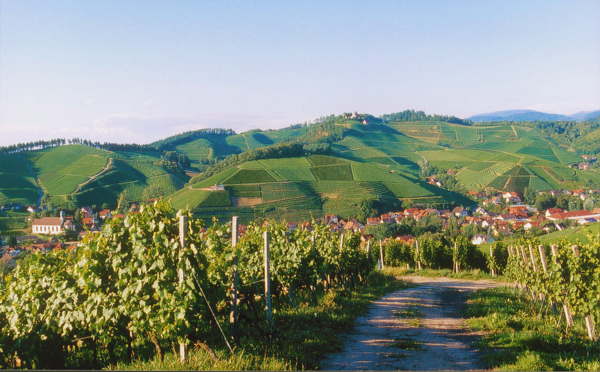 The Durbach Valley, just twelve kilometers long, forms a manageable and almost self-contained unit with its many small side valleys. Due to its sheltered location between the mountain ridges that keep the cold air from the Rhine Valley at bay, Durbach enjoys a very mild climate year-round – one reason for its exceptionally favorable location for fruit and wine growing. The vines cultivated here are planted on steep, rocky, weathered granite soils. Wine is grown on almost all slopes up to an altitude of around 400 meters – due to the topographical location, almost exclusively on steep slopes. Steep slopes require considerable effort, manual cultivation, and hand-picking. They produce low yields in favor of the highest quality.
The Durbach Valley, just twelve kilometers long, forms a manageable and almost self-contained unit with its many small side valleys. Due to its sheltered location between the mountain ridges that keep the cold air from the Rhine Valley at bay, Durbach enjoys a very mild climate year-round – one reason for its exceptionally favorable location for fruit and wine growing. The vines cultivated here are planted on steep, rocky, weathered granite soils. Wine is grown on almost all slopes up to an altitude of around 400 meters – due to the topographical location, almost exclusively on steep slopes. Steep slopes require considerable effort, manual cultivation, and hand-picking. They produce low yields in favor of the highest quality.
Looking down from the heights at golden Durbach—also called the Golden Village because of the many awards its wines have received—and its beautifully rolling hills, it's easy to understand why everything here has revolved around wine since the 14th century. In recent decades, Durbach has developed into a true hiking paradise and offers everything you need for a relaxing holiday.
But Durbach is just one of the many picturesque villages in the Ortenau region, one of the nine wine-growing areas of the Baden wine-growing region at the foot of the Black Forest. The area stretches over 60 kilometers between Rastatt and Offenburg. Here, one finds a clear three-dimensional landscape, consisting of vineyards in the middle, flanked by fertile Rhine meadows on one side and the romantic Black Forest mountains on the other. Everything thrives lushly: corn, tobacco, and fruit on the plains, forests and game on the hills, and vines everywhere in between. The resulting wines are characterized by the mild climate, over 1,700 hours of sunshine annually, and the granite-weathered soils. The precipitation from the Black Forest ridge gives the wines their fruitiness and elegant lightness. This so-called border climate of the upper elevations is ideal for Riesling.
Thus, each of the nine areas of the Baden wine-growing region has its own unique characteristics. Yet it's not just the diversity of grape varieties in Germany's southernmost wine-growing region, Baden, which stretches over 400 km from the Odenwald forest across the Upper Rhine Plain to Lake Constance and is the only German wine-growing region to belong to wine-growing zone B of the European Community, along with Alsace, Champagne, and the Loire Valley. Baden also generally has higher minimum standards for quality and Prädikat wines. The climate is particularly sunny and warm. Significant differences in altitude, soil, and climatic conditions result in a fascinating variety of wines, from dry to sweet, both in the white and red wine categories.
Text: Horst Kröber, Photos: PR, unless otherwise stated
